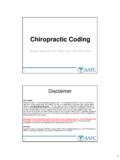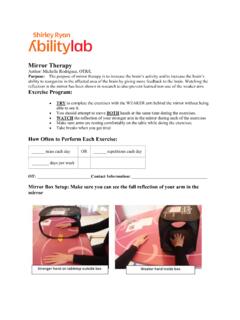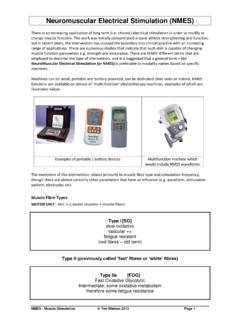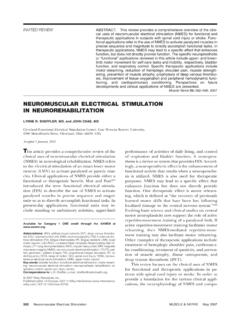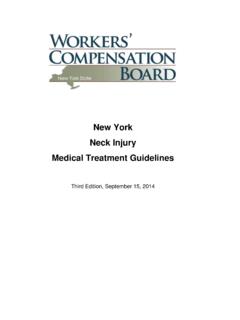Transcription of Principles of Electrosurgery
1 Principles of ElectrosurgeryIntroductionThe Covidien Energy-based Professional Education, Department of Clinical Education is pleased to provide you with this educational booklet on Electrosurgery . Designed to explain the essential Principles of one of the most widely utilized technologies available to surgeons, it emphasizes clinical efficacy and patient information represents Covidien s ongoing commitment to meet the educational needs of the surgical team. As partners in the delivery of perioperative care, we must work together to achieve the highest standards in patient care and optimal patient booklet contains excerpts from the many educational programs available from Valleylab, an accredited provider of nursing continuing education. To schedule programming or for additional information call 800-255-8522, ext. 6240. Please contact us if we may be of Information HotlineTo answer clinical questions of a more immediate nature, Covidien has established a Clinical Information Hotline.
2 You may access this valuable service 24 hours a day by calling 800-255-8522, ext. Offerings from Covidien Energy-based Professional Education, Department of Clinical EducationAdvanced Energy-Based Applications and Program hours vary Technology The Art and Science of Electrosurgery : Program hours vary Principles , Applications and Risks to meet the needs of the Art and Science of Minimally Invasive Program hours vary Surgery: Principles , Applications and RisksBest Practices for Electrosurgery 1 or 2 contact hoursElectrosurgical Best Practices for 1 contact hour Minimally Invasive Procedures Electrosurgery Continuing Education Module 2 contact hours (online at ) Electrosurgery : Perioperative Liability Issues 1 contact hourElectrosurgery Self-Study Guide 2 contact hoursFire Prevention and Safety During Surgical 1 contact hour Procedures (also available on CD-ROM and online) Innovations in Electrosurgery : 1 contact hour High Force Controlled RF Vessel Fusion (also available on CD-ROM) Recommended Practices for Electrosurgery 1 contact hourSurgical Smoke: Hazards and Controls 2 contact hoursSurgical Smoke Self-Study Guide 1 contact hourZap Facts contact hoursAccreditation StatementThe Covidien Energy-based Professional Education is approved as a provider of continuing education in nursing by the Colorado Nurses Association, an accredited approver by the American Nurses Credentialing Center s Commission on approved refers to recognition of educational offerings only and does not imply approval or endorsement of any product of Covidien.
3 Covidien Energy-based Professional Education provider numbers are available upon request by calling the Clinical Education Department at 800-255-8522, ext. of ContentsProperties of Electricity .. 2 Principles of Electrosurgery ..2 Bipolar Electrosurgery ..4 Monopolar Electrosurgery ..4 Tissue Effects Change as You Modify the Waveform ..5 Electrosurgical Tissue Effects ..6 Grounded Electrosurgical Systems ..7 Isolated Electrosurgical Systems ..8 Patient Return Electrodes ..9 Patient Return Electrode Monitoring Technology ..11 Adaptive Technologies ..12 Radio Frequency Ablation ..14 Electrosurgery Safety Concerns During MIS ..16 Capacitive Coupling During Endoscopy ..17 Recommendations to Avoid Electrosurgical Patient Complications in MIS ..18 Coated Electrodes ..18 Argon-Enhanced Electrosurgery ..19 Surgical Smoke .. 20OR Safety Precautions ..21 Key Terms ..22 Bibliography ..242 PrOPErTIES Of ElECTrICITy Several properties of electricity must be understood in order to understand Electrosurgery .
4 Electrons orbit the nuclei of atoms. Current flow occurs when electrons flow from one atom to the orbit of an adjacent atom. Voltage is the force or push that provides electrons with the ability to travel from atom to atom. If electrons encounter resistance, heat can be produced. The resistance to electron flow is called completed circuit must be present in order for electrons to flow. A completed circuit is an intact pathway through which electrons can travel. In this diagram, voltage is generated by the power plant, providing the force to push electrons through the circuit. The original source of these electrons is the earth (ground). To complete the circuit the electrons must return to ground. Any grounded object can complete the circuit, allowing the electrons to flow to = flow of electrons during a period of time, measured in amperesCircuit = Pathway for the uninterrupted flow of electronsVoltage = force pushing current through the resistance, measured in voltsImpedance/ Obstacle to the flow of current, resistance = measured in ohms (impedance = resistance) Principles Of Electrosurgery Electrocautery Often electrocautery is used to describe Electrosurgery .
5 This is incorrect. Electrocautery refers to direct current (electrons flowing in one direction) whereas Electrosurgery uses alternating current. During electrocautery, current does not enter the patient s body. Only the heated wire comes in contact with tissue. In Electrosurgery , the patient is included in the circuit and current enters the patient s SpectrumStandard electrical current alternates at a frequency of 60 cycles per second (Hz). Electrosurgical systems could function at this frequency, but because current would be transmitted through body tissue at 60 cycles, excessive neuromuscular stimulation and perhaps electrocution would result. Because nerve and muscle stimulation cease at 100,000 cycles/second (100 kHz), Electrosurgery can be performed safely at radio frequencies above 100 kHz. An electrosurgical generator takes 60 cycle current and increases the frequency to over 200,000 cycles per second. At this frequency electrosurgical energy can pass through the patient with minimal neuromuscular stimulation and no risk of of Electrosurgery in the of electricity are relevant in the operating room.
6 The electrosurgical generator is the source of the electron flow and voltage. The circuit is composed of the generator, active electrode, patient and patient return electrode. Pathways to ground are numerous but may include the table, stirrups, staff members and equipment. The patient s tissue provides the impedance, producing heat as the electrons overcome the impedance.*The circuit for the alternating current is depicted by arrows in opposite *4 BIPOlAr Electrosurgery BipolarIn bipolar Electrosurgery , both the active electrode and return electrode functions are performed at the site of surgery. The two tines of the forceps perform the active and return electrode functions. Only the tissue grasped is included in the electrical circuit. Because the return function is performed by one tine of the forceps, no patient return electrode is CircuitThis picture represents a typical bipolar output and patient return functions are both accomplished at the site of path is confined to tissue grasped between forceps return electrode should not be applied for bipolar only Electrosurgery MonopolarMonopolar is the most commonly used electrosurgical modality.
7 This is due to its versatility and clinical effectiveness. In monopolar Electrosurgery , the active electrode is in the surgical site. The patient return electrode is somewhere else on the patient s body. The current passes through the patient as it completes the circuit from the active electrode to the patient return active electrode is in the wound. The patient return electrode is attached somewhere else on the current must flow through the patient to the patient return CircuitThis picture represents a common monopolar circuit. There are four components to the monopolar circuit:generator Active Electrode Patient Patient return Electrode TISSuE EffECTS CHAngE AS yOu MODIfy THE WAVEfOrM Electrosurgical generators are able to produce a variety of electrical waveforms. As waveforms change, so will the corresponding tissue effects. Using a constant waveform, like cut, the surgeon is able to vaporize or cut tissue.
8 This waveform produces heat very rapidly. Using an intermittent waveform, like coagulation, causes the generator to modify the waveform so that the duty cycle ( on time) is reduced. This interrupted waveform will produce less heat. Instead of tissue vaporization, a coagulum is blended current is not a mixture of both cutting and coagulation current but rather a modification of the duty cycle. As you go from Blend 1 to Blend 3 the duty cycle is progressively reduced. A lower duty cycle produces less heat. Consequently, Blend 1 is able to vaporize tissue with minimal hemostasis whereas Blend 3 is less effective at cutting but has maximum only variable that determines whether one waveform vaporizes tissue and another produces a coagulum is the rate at which heat is produced. High heat produced rapidly causes vaporization. Low heat produced more slowly creates a coagulum. Any one of the five waveforms can accomplish both tasks by modifying the variables that impact tissue VoltageHigh VoltageTypical Example100% on50% on50% off40% on60% off25% on75% off6% on94% off6 ElECTrOSurgICAl TISSuE EffECTS Electrosurgical CuttingElectrosurgical cutting divides tissue with electric sparks that focus intense heat at the surgical site.
9 By sparking to tissue, the surgeon produces maximum current concentration. To create this spark the surgeon should hold the electrode slightly away from the tissue. This will produce the greatest amount of heat over a very short period of time, which results in vaporization of fulguration (sparking with the coagulation waveform) coagulates and chars the tissue over a wide area. Since the duty cycle (on time) is only about 6 percent, less heat is produced. The result is the creation of a coagulum rather than cellular vaporization. In order to overcome the high impedance of air, the coagulation waveform has significantly higher voltage than the cutting current. Use of high voltage coagulation current has implications during minimally invasive surgery. DesiccationElectrosurgical desiccation occurs when the electrode is in direct contact with the tissue. Desiccation is achieved most efficiently with the cutting current. By touching the tissue with the electrode, the current concentration is reduced.
10 Less heat is generated and no cutting action occurs. The cells dry out and form a coagulum rather than vaporize and surgeons routinely cut with the coagulation current. Likewise, you can coagulate with the cutting current by holding the electrode in direct contact with tissue. It may be necessary to adjust power settings and electrode size to achieve the desired surgical effect. The benefit of coagulating with the cutting current is that you will be using far less voltage. Likewise, cutting with the cut current will also accomplish the task with less voltage. This is an important consideration during minimally invasive voltage waveform100% duty cycleCoagHigh voltage waveform6% duty cycleCoagBlendPure CutLowLowThermal Spread/CharringVoltageHighHigh7 Variables Impacting Tissue EffectIn addition to waveform and power setting, other variables impact tissue effect. They include: Size of the electrode: The smaller the electrode, the higher the current concentration.


